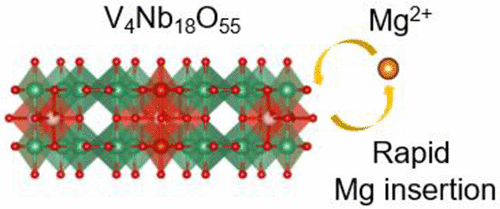当前位置:
X-MOL 学术
›
Inorg. Chem.
›
论文详情
Our official English website, www.x-mol.net, welcomes your feedback! (Note: you will need to create a separate account there.)
Probing Mg Intercalation in the Tetragonal Tungsten Bronze Framework V4Nb18O55.
Inorganic Chemistry ( IF 4.6 ) Pub Date : 2020-07-07 , DOI: 10.1021/acs.inorgchem.0c01013 Ian D Johnson 1 , Gene Nolis 2, 3 , Kit McColl 1 , Yimin A Wu 3, 4 , Daisy Thornton 1 , Linhua Hu 2, 3 , Hyun Deog Yoo 5 , John W Freeland 6 , Furio Corà 1 , Jeremy K Cockcroft 1 , Ivan P Parkin 1 , Robert F Klie 4 , Jordi Cabana 2, 3 , Jawwad A Darr 1
Inorganic Chemistry ( IF 4.6 ) Pub Date : 2020-07-07 , DOI: 10.1021/acs.inorgchem.0c01013 Ian D Johnson 1 , Gene Nolis 2, 3 , Kit McColl 1 , Yimin A Wu 3, 4 , Daisy Thornton 1 , Linhua Hu 2, 3 , Hyun Deog Yoo 5 , John W Freeland 6 , Furio Corà 1 , Jeremy K Cockcroft 1 , Ivan P Parkin 1 , Robert F Klie 4 , Jordi Cabana 2, 3 , Jawwad A Darr 1
Affiliation

|
While commercial Li-ion batteries offer the highest energy densities of current rechargeable battery technologies, their energy storage limit has almost been achieved. Therefore, there is considerable interest in Mg batteries, which could offer increased energy densities in comparison to Li-ion batteries if a high-voltage electrode material, such as a transition-metal oxide, can be developed. However, there are currently very few oxide materials which have demonstrated reversible and efficient Mg2+ insertion and extraction at high voltages; this is thought to be due to poor Mg2+ diffusion kinetics within the oxide structural framework. Herein, the authors provide conclusive evidence of electrochemical insertion of Mg2+ into the tetragonal tungsten bronze V4Nb18O55, with a maximum reversible electrochemical capacity of 75 mA h g–1, which corresponds to a magnesiated composition of Mg4V4Nb18O55. Experimental electrochemical magnesiation/demagnesiation revealed a large voltage hysteresis with charge/discharge (1.12 V vs Mg/Mg2+); when magnesiation is limited to a composition of Mg2V4Nb18O55, this hysteresis can be reduced to only 0.5 V. Hybrid-exchange density functional theory (DFT) calculations suggest that a limited number of Mg sites are accessible via low-energy diffusion pathways, but that larger kinetic barriers need to be overcome to access the entire structure. The reversible Mg2+ intercalation involved concurrent V and Nb redox activity and changes in crystal structure, as confirmed by an array of complementary methods, including powder X-ray diffraction, X-ray absorption spectroscopy, and energy-dispersive X-ray spectroscopy. Consequently, it can be concluded that the tetragonal tungsten bronzes show promise as intercalation electrode materials for Mg batteries.
中文翻译:

在四方钨青铜框架V4Nb18O55中探测镁的嵌入。
尽管商用锂离子电池提供了当前可充电电池技术的最高能量密度,但它们的能量存储极限几乎已达到。因此,Mg电池引起了极大的兴趣,如果可以开发出高压电极材料(例如过渡金属氧化物),则与Li离子电池相比,Mg电池可以提供更高的能量密度。但是,目前很少有氧化物材料在高电压下表现出可逆和有效的Mg 2+插入和提取。据认为这是由于氧化物结构框架内的Mg 2+扩散动力学较差所致。本文中,作者提供了将Mg 2+电化学插入四方钨青铜V中的确凿证据。4 Nb 18 O 55,最大可逆电化学容量为75 mA hg –1,对应于Mg 4 V 4 Nb 18 O 55的镁化成分。实验电化学放大/缩小显示了带充电/放电的大电压迟滞(1.12 V vs Mg / Mg 2+);当放大倍数仅限于Mg 2 V 4 Nb 18 O 55的成分时,该磁滞可降低至0.5V。混合交换密度泛函理论(DFT)计算表明,可通过低能量扩散途径访问有限数量的Mg位置,但需要克服较大的动力学障碍才能进入整个结构。可逆的Mg 2+嵌入涉及同时的V和Nb氧化还原活性以及晶体结构的变化,这已通过一系列互补方法得到了证实,包括粉末X射线衍射,X射线吸收光谱和能量色散X射线光谱。因此,可以得出结论,四方钨青铜显示出有望用作Mg电池的嵌入电极材料。
更新日期:2020-07-20
中文翻译:

在四方钨青铜框架V4Nb18O55中探测镁的嵌入。
尽管商用锂离子电池提供了当前可充电电池技术的最高能量密度,但它们的能量存储极限几乎已达到。因此,Mg电池引起了极大的兴趣,如果可以开发出高压电极材料(例如过渡金属氧化物),则与Li离子电池相比,Mg电池可以提供更高的能量密度。但是,目前很少有氧化物材料在高电压下表现出可逆和有效的Mg 2+插入和提取。据认为这是由于氧化物结构框架内的Mg 2+扩散动力学较差所致。本文中,作者提供了将Mg 2+电化学插入四方钨青铜V中的确凿证据。4 Nb 18 O 55,最大可逆电化学容量为75 mA hg –1,对应于Mg 4 V 4 Nb 18 O 55的镁化成分。实验电化学放大/缩小显示了带充电/放电的大电压迟滞(1.12 V vs Mg / Mg 2+);当放大倍数仅限于Mg 2 V 4 Nb 18 O 55的成分时,该磁滞可降低至0.5V。混合交换密度泛函理论(DFT)计算表明,可通过低能量扩散途径访问有限数量的Mg位置,但需要克服较大的动力学障碍才能进入整个结构。可逆的Mg 2+嵌入涉及同时的V和Nb氧化还原活性以及晶体结构的变化,这已通过一系列互补方法得到了证实,包括粉末X射线衍射,X射线吸收光谱和能量色散X射线光谱。因此,可以得出结论,四方钨青铜显示出有望用作Mg电池的嵌入电极材料。



























 京公网安备 11010802027423号
京公网安备 11010802027423号